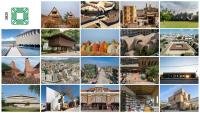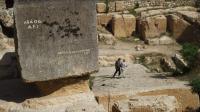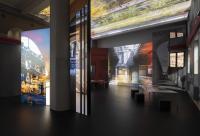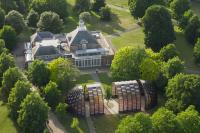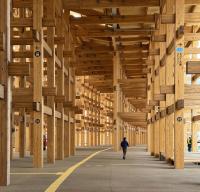PAL International School@TUFS
Tokyo, Japan
An international school which provides nursery and after school program designed on the campus of Tokyo University of Foreign Studies.
The site was designated at the end of a tree-lined avenue extending from the university’s central plaza. It was a hill-like place with a height difference of about 2 meters, and I was explained that the hill was made of the leftover soil that had been piled up when the student dormitory next to it was built. The site was segregated by surrounding chain link fence, and it seemed detached from the entire campus as being located at the far end where weeds grow so thick that you might hesitate to enter in the summer. There was a cut in the center that divided the hill into two, and a smoking area was set up at the back, probably because it was out of sight from the surrounding area.
Above explanation may give a negative impression, but when I first visited the site, my impression was the exact opposite. Its location on the large university campus, at the end of a tree-lined avenue that extends from the central plaza, was very easy to find, and beyond that, the road outside the campus was lined with attractive cherry blossom trees.
It is common for nursery schools to build artificial hills in their gardens, and after consulting with the director, we decided to use an existing hill as an artificial hill. The assumption is that the entire garden is an artificial hill and would be positively used as a three-dimensional field to accept the activities and imagination of the children. In order to reduce the amount of soil removed during construction, the school building was built away from the center of the hill, moved to the side, and stretched along a road in front which is lined with cherry blossom trees. The roof of the nursery building is kept low so that when you stand on the hill, you can see the surrounding trees and scenery.
There is an outdoor hallway under the eaves of the roof, and a retaining wall separates the hallway from the hill. In order to minimize the earthwork, we opted to narrow hallway where hill is high and amount of soil is large by pushing retaining wall toward the building and broaden the hallway where hill is low. However, due to operational requirements, the hallway was broadened where wide hallway was requested to put sofas for children to gather or there is a lot of traffic and narrowed in front of the playground for children aged 0 to 1 to ensure safety. The location of the earth retaining wall was considered in order to balance both conditions. As a result, the hallway and the hill are connected by earth retaining walls that are cranked at seven locations along the 47m length of the building, and the eaves are also extended and cranked accordingly. To prevent rain from entering the hallway, the top edge of the retaining wall was cut diagonally toward the hill.
Facing the hallway, there are many sliding door sashes that allow access from many places in the room. On the front road side opposite the hallway, a high window sashes were installed just below the roof in a position where branches of the cherry blossom trees can be seen. The long side of the nursery building is 47m, but the short side is only 4.5m, so if you open the sashes on both sides, you can ensure ventilation in 4.5m. In the summer, the rows of cherry blossom trees provide shade from the morning sun coming from the east, and in the winter, when the leaves fall, the sunlight reaches indoors. The eaves and the adjacent student dormitory block the sunset from the west.
The structure is made of wood in consideration of versatility and cost, and the cross section and length (6m or less) meet residential standards. The short side of the nursery building is 4.5m, but the eaves that extend from it are a maximum of 2.7m, and the total length exceeds 6m, so the length can be adjusted by sliding a beam held at the tip like a “chopstick gun”. This allows the eaves, which have different lengths depending on the crank, to be supported by the same structural unit. This unit was repeated in 14 sets over the 47m long length of the building, and was used as the interior design.
There is a shuttle bus stop next to the entrance. Although the nursery school was built on a university campus, it accepts children not only from the university but also from the vicinity. Children from various countries outside Japan attend the school, including Senegal, Uganda, the United States, China, South Korea, and others, and the same goes for the staff. For example, school lunch is prepared by someone from Uzbekistan, and her local cuisine could be served at lunch.
Inside the garden, a route has been set around the hill for cars to go through the site from the entrance side to the bus stop at the frontal road. The range of activities is expected to expand as various functions such as a mobile tea room and a camper for overnight childcare are introduced and “plugged in” to the nursery school. At the school’s first anniversary celebration, food trucks came and many people lined up for food, international families and local residents visited, and cheerleading demonstrations by students were crowded with many people.
The university’s central plaza is the hub of campus circulation, and is literally the center of university activities, serving as the main venue filled with stalls for events such as university festivals. Creating “another plaza” to the university’s central plaza was the concept of designing the nursery school which was intended to add a “childcare” activity at the end of the tree-lined avenue that extends from the central plaza. The basic design principle is to restructure the space by placing a low-height wooden school building as part of the abandoned hill and to turn the childcare activities into a landscape beyond the tree-lined avenue. We could sense this concept is being nurtured through the bustling first anniversary celebration.
We hope that connecting “another plaza” with the central plaza in this way will highlight the characteristics of both and lay the groundwork for creating new value and interest. Many ideas were exchanged in the conversation at the early stage between the nursery school director and the university president such as “How about delivering lunch prepared in the nursery school cafeteria to students in a similar way to UberEats?” “How about students studying on early childhood education to participate in childcare as interns?” Some of these have already been realized, and many more will be developed in the future.
On a separate note, this is a project funded by crowdfunding, whose target amount was achieved in a matter of 17 seconds after the call started, and in the end, more than 1,000 investors applied for the project, raising nearly three times the goal. At the design meeting, the university president said, “It’s been our long-standing desire to build a nursery school at the university,” which I left me an impression that inner circle of the university which has more women by gender ratio had much expectation to the project. However, the features of this nursery school lie in creating new values and excitements around children while making the most of the university environment not just serving to their need for childcare. We feel that the expectation for the nursery school to provide more than its primary role of childcare against the backdrop of the society in general is coming from far beyond the framework of the university.
The Japanese government established the Children and Families Agency in early 2023 advocating “children-centered society.” This project achieved the fastest record of crowdfunding which does not seem to be broken any time soon. We believe these are only a few testaments to this surging trend.
- Architecten
- Akio Nakasa / Naf Architect & Design
- Locatie
- Tokyo, Japan
- Jaar
- 2022

































